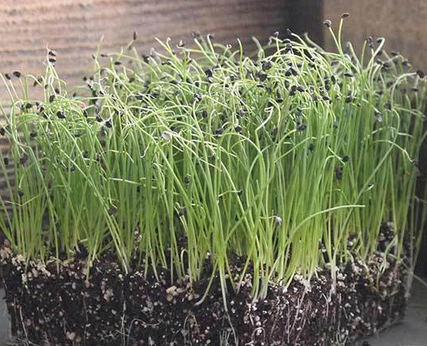
Hippocrates, the 4th century B.C. Greek father of medicine, once said, “Let thy food be thy medicine and thy medicine be thy food.” When it comes to chronic illnesses such as heart disease and diabetes, there is a lot of evidence that food has healing properties enabling it to restore or maintain good health.
Microgreens are usually classified with seaweed, nutrition yeast, juicing grasses like wheatgrass, and herbs as “medicinal foods.” They have been cited as providing specific measurable benefits just like those of synthetic drugs. In a 2009 study in the Journal of Oxidative Medicine and Cellular Longevity, the authors cited that “long-term consumption of diets rich in plant polyphenols offer protection against the development of cancers, cardiovascular diseases, diabetes, osteoporosis, and neurodegenerative diseases.”
Polyphenols are important natural chemicals found in many foods and contain powerful antioxidant properties. Antioxidants help prevent the buildup of harmful free radicals, which are highly reactive compounds that form in the body and can cause damage to cells as well as chronic disease. Research suggests polyphenols have been associated with a reduced risk of heart disease, cancer and Alzheimer’s disease. A 2013 study out of Maryland measured the amount of polyphenols in five microgreens from the Brassica family of vegetables, including red cabbage, purple kohlrabi, mizuna and red and purple mustard greens. Not only were the microgreens found to be good sources of polyphenols, but they actually contained a wider variety of polyphenols than their mature vegetable counterparts. Coupled with a balanced diet, healthy lifestyle and regular physical activity, incorporating a serving or two of microgreens into your day could help keep your heart strong and healthy.
If you’re looking for ideas of how to eat microgreens, here are some easy recipes you can try:
Available Microgreens
Broccoli Microgreens

Broccoli microgreens have a high sulforaphane content with a mild broccoli flavor. Non-GMO. It is a hardy and substantial microgreen that has a fresh, mild cabbage flavor. They are also favored for their health benefits, being a great source of sulforaphane. It is an excellent choice as a base for any micro greens salad.
Latin Name: Brassica oleracea
Color: Thin white stem with shades of green on top
Flavor: Fresh, mild broccoli or cabbage flavor
Texture: Soft
Nutrients: Vitamins A and C, sulforaphane, calcium, iron, and phosphorus
Red Cabbage Microgreens

Gorgeous purple hue and mild taste makes this a staple. It not only brightens up the salad, but it tastes great too! Good anti inflammatory, aids digestion, helps lower blood pressure & cholesterol.
Latin Name: Brassica oleracea capitata rubra
Color: Whitish stems and green cotyledons with red to purple highlights
Flavor: Light, mild but refreshing flavour
Texture: Crunchy and juicy
Nutrients: High in vitamins A, B-6, C, Potassium, Sodium
Beet Detroit Dark Red Microgreens

The bright stems and leaves look fantastic on any dish! Beets have so many healthy qualities! Alleviates hypertension and cardiovascular disease. Powerful detoxifying and antioxidant properties. Improves immune functions. Aids in preventing stroke, heart disease, risk of Type II diabetes and epileptic seizures. Stress relief. Slows the aging process.
Latin Name: Beta vulgaris
Color: Vibrant red stem with a nearly neon green top
Flavor: Sweet and earthy
Texture: Crunchy and juicy
Nutrients: Vitamins A, B, C, E, and K, calcium, magnesium, potassium, iron, zinc, and protein
China Rose Sprouting Radish Microgreens

Radish microgreens are packed with nutritional benefits! Anti-inflammatory, which reduces swelling and pain in the body. Natural diuretic, which can aid in reducing blood pressure. Helps detoxify and cleanse the body. Relief of indigestion or flatulence. Radish is a green with an intense radish flavor. Use in any dish in place of sliced radish.
Latin Name: Raphanus sativus
Color: Vibrant pink stem with a deep green top
Flavor: Spicy & floral with a hint of sweetness
Texture: Crunchy and succulent
Nutrients: Vitamins A, B, C, E, & K, folic acid, niacin, potassium, iron, phosphorus, pantothenic acid, calcium, magnesium, zinc, carotenes
Early Mizuna Mustard Microgreens

Mustard Microgreens come in different types, some spicier than others, like the red mustard. This variety is pleasantly less spicy than its full counterpart while still honoring the flavor. This mustard microgreen is nothing like the mustard you buy in the supermarket. It is tender, juicy and filled with nutrition! Mizuna mustard microgreens add a mild but sweet and spicy flavor to your next meal.
Latin Name: Brassica rapa nipposinica
Color: Bright yellow to white stem with a bright geen top
Flavor: Bold mustard flavor with mild spice
Texture: Tender and Juicy
Nutrients: Antioxidants, fiber, Vitamins A,C, E, and K
Organic Green Pea Sprouting Microgreens

These pea microgreens get nice and tall, with a beautiful vibrant green color. They are sweet, taste strongly of fresh peas, and the tendrils they grow make them look like living lace. This variety has the biggest crunchiest tendrils and can keep for weeks! Pea microgreens can aid in diabetes, cancer prevention and overall heart health. They are high in antioxidants and phytonutrients, which are necessary in supporting the body's inflammation system.
Latin Name: Pisum sativum
Color: Green
Flavor: Sweet, fresh pea taste
Texture: Crunchy and succulent
Nutrients: Vitamins A, C, E, B1, B2, B3, B6, protein, fiber, omega-3 and micronutrients
Pea, Snow Dwarf Sugar Grey Microgreens

Snow pea microgreens are an excellent source of these three protective agents: folate, antioxidants and carotene. Folate aids in the production and maintenance of cells, as well as protects against DNA damage. Antioxidants fight against free radical damage, which lowers the risk of cancer, Carotenes are helpful antioxidants that specifically protect the body from disease and strengthen the immune system.
Latin Name: Pisum sativum
Color: Green
Flavor: Sweet, fresh pea taste
Texture: Crunchy and succulent
Nutrients: Vitamins A, C, E, B1, B2, B3, B6, protein, fiber, omega-3 and micronutrients
Speckled Pea Microgreens

The speckled pea microgreens feature a traditional sweet, green pea flavor. Very nutritious, delicious and inexpensive addition to sandwiches and salads. People love the fresh taste and texture! Pea microgreens can aid in diabetes, cancer prevention and overall heart health. They are high in antioxidants and phytonutrients, which are necessary in supporting the body's inflammation system.
Latin Name: Pisum sativum
Color: Green
Flavor: Sweet, fresh pea taste
Texture: Crunchy and succulent
Nutrients: Vitamins A, C, E, B1, B2, B3, B6, protein, fiber, omega-3 and micronutrients
Tokyo Long White Bunching Onion Microgreens

Tokyo long white bunching onion microgreens are very rich in flavor and nutrients. Put just a couple greens in a soup, sandwich or salad and taste the flavor! Seed hulls are left on to provide an additional crunch. Best to start tasting small amounts so you can gauge how strong they really are!
Latin Name: Allium fistulosum
Color: Light Green
Flavor: Full Onion Flavor, Similar to Chives
Texture: Soft (extra crunch provided by seed hulls)
Nutrients: Vitamins A, B, C, E, and K, folic acid, niacin, potassium, iron, phosphorus, pantothenic acid, calcium, magnesium, zinc, carotenes.
More Health Info...
Vitamins are organic compounds made by plants and animals which can be broken down by heat, acid or air. On the other hand, minerals are inorganic, exist in soil or water and cannot be broken down. When you eat, you consume the vitamins that plants and animals created or the minerals they absorbed. The micronutrient content of each food is different, so it’s best to eat a variety of foods to get enough vitamins and minerals. An adequate intake of all micronutrients is necessary for optimal health, as each vitamin and mineral have a specific role in your body. Vitamins and minerals are divided into four groups: water-soluble vitamins, fat-soluble vitamins, macro minerals and trace minerals.
No matter what type, they are absorbed the same way in your body and work together in the body. Rotating microgreens and other foods regularly help to limit over-consumption of any single anti-nutrient and provides health-promoting variety in your diet. In addition, by adding microgreens to your meals will also help to close any gaps in your vitamin or mineral intake.
Fat-soluble Vitamins
There are four fat-soluble vitamins in the human diet.
Vitamin A helps maintain your vision. So much so that without it plays you would go blind. The main sources of Vitamin A are retinoids and carotenoid antioxidants known as provitamin A. The most efficient of these is beta-carotene, which is abundant in many microgreens, such as kale and spinach.
Recommended Daily Amount of Vitamin A
| Upper Limit | Adult Men | Adult Women | Children |
| 10,000 IU (900 mcg) | 3,000 IU ( mcg) | 2,333 (700 mcg) | 1,000 IU (300 mcg) to 2,000 IU (600 mcg) |
Vitamin D maintains the balance of c900alcium and phosphorus levels in your blood to maintain bone health. The main source of vitamin D is Vitamin D2, found in mushrooms and plants. Amaranth and sunflower microgreens are packed with Vitamin D.
Recommended Daily Amount of Vitamin D
| Upper Limit | Adults and Children | Elderly Adults |
| 4,000 IU (100 mcg) | 600 IU (15 mcg) | 800 IU (20 mcg) |
Vitamin E is a group of related antioxidant compounds (tocopherol and tocotrienol) which act in the body to protect cells against free radicals and oxidative damage. Spinach, cilantro, green daikon radish, and sunflower microgreens are packed with Vitamin E.
Recommended Daily Amount of Vitamin E
| Upper Limit | Adults and Children over 14 | Breastfeeding Women |
| 1500 IU (1,000 mg) | 22 IU (15 mg/s) of alpha-tocopherol | 28 IU (19 mg) |
Vitamin K plays a key role in blood clotting. Without it, you would run the risk of bleeding to death. The main dietary forms are vitamin K1, found in plant foods. Spinach, kale and broccoli microgreens are packed with Vitamin K. However, consult your physician as Vitamin K can affect the liver, and should never be taken as a supplement if a patient is on blood thinners,
Recommended Daily Amount of Vitamin K
| Upper Limit | Adult Men | Adult Women | Children |
| UNKNOWN | 120 mcg | 90 mcg | 30-75 mcg |
Water-soluble Vitamins
There are 8 water-soluble B vitamins as well as vitamin C.
Vitamin B1 (thiamine)
Vitamin B2 (riboflavin)
Vitamin B3 (niacin)
Vitamin B5 (pantothenic acid)
Vitamin B6
Vitamin B7 (biotin)
Vitamin B9 (folic acid)
Vitamin B12 (cobalamin)
Vitamin C
Except for Niacin (Vitamin B3) there are no known side effects or toxicity at high doses. The common side effect of too much Vitamin B3 are diarrhea, nausea and abdominal cramps.
| Adult Men | Adult Women | Breastfeeding Women | |
| Vitamin B1 (thiamine) | 1.2 mg | 1.1 mg | 1.7 mg |
| Vitamin B2 (riboflavin) | 1.3 mg | 1.1 mg | 2.0 mg |
| Vitamin B3 (niacin) | 16.0 mg | 14.0 mg | 20.0 mg |
| Vitamin B5 (pantothenic acid) | 5.0 mg | 5.0 mg | 10.0 mg |
| Vitamin B6 (pyridoxine) | 1.3 mg | 1.3 mg | 2.0 mg |
| Vitamin B7 (biotin) | 30 mcg | 30 mcg | 300 mcg |
| Vitamin B9 (folic acid, folate) | 400 mcg | 400 mcg | 800 mcg |
| Vitamin B12 (cobalamin) | 2.4 mcg | 2.4 mcg | 8.0 mcg |
| Vitamin C | 90 mg | 75 mg | 120 mg |
These vitamins enhance the enzymes that help us digest and absorb nutrients in our bodies. Your body doesn’t store water-soluble vitamins, except for vitamin B12. So, eating a balanced diet with lots of microgreens daily should get you what you need.
